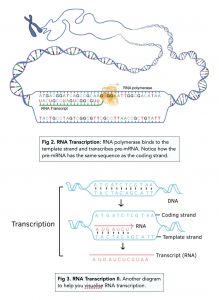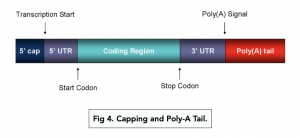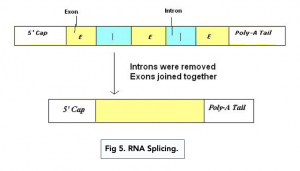Transcription (A-level Biology)
Transcription
Synthesis of mRNA
The Process of Transcription
During transcription, a strand of mRNA is synthesised from a particular gene template.
- Transcription factor binds to promoter region. A transcription factor binds to a promoter of a particular gene. The binding of a transcription factor to a promoter leads to the recruitment of several key enzymes and proteins to the gene.
- DNA helicase unwinds the gene region. DNA helicase unwinds the gene region by breaking the hydrogen bonds between the two strands of DNA. This exposes the bases on each strand. The two unwound strands of DNA are referred to as either the coding strand or the template strand. This strand is also sometimes known as antisense DNA.
- Enzyme RNA polymerase binds. The enzyme RNA polymerase binds in a region just before the start codon of the gene.
- RNA polymerase transcribes the mRNA. RNA polymerase reads the nucleotides on the unwound template (antisense) strand of DNA. It then recruits nucleotides and continually makes a strand of RNA. The growing mRNA strand lengthens in the 5’ to 3’ direction.
- RNA polymerase reaches the stop codon. RNA polymerase stops transcribing mRNA once it reaches the stop codon.
- The resulting strand of RNA is known as pre-mRNA. The pre-mRNA will have the complimentary sequence to the coding strand, except all thymine bases will be will be replaced with uracil bases.

Post-Transcription Splicing
In prokaryotes, transcription directly leads to an mRNA. However, in eukaryotes, transcription makes pre-mRNA, which then has to be spliced to make mRNA. We learn about the process below.
Capping and Poly-A Tail
- The pre-mRNA needs to be modified before leaving the nucleus. Following transcription, the pre-mRNA needs to be modified before it can exit the nucleus and travel to the ribosomes.
- The cytoplasm contains several dangers to the mRNA. The greatest risk to mRNA comes from enzymes known as exonucleases and endonucleases. These are enzymes which destroy nucleic acids and are part of a defence mechanism against viral infections. However, these endonucleases and exonucleases cannot discriminate between viral nucleic acids and the mRNA, so would just attack normal mRNA.
- To prevent destruction of mRNA, two major modifications are made:
- 5’ cap – the 5’ end of the mRNA is altered to produce a 5’ cap which:
- Protects mRNA from nucleases.
- 5’ cap is required for mRNA binding to ribosomes.
- Poly-A tail – lots of adenines (A) are added to the 3’ end to make a poly-A tail, which:
-
- Protects mRNA from nucleases.
- Facilitates the exit of the mRNA from the nucleus through pores in the nuclear membrane.
- When the 5’cap of the mRNA binds to the ribosome, the poly-A tail loops around and binds to the top of the ribosome and enhances the efficiency with which the ribosomes read the mRNA.

RNA Splicing
- The pre-mRNA contains both exons and introns. Before the mRNA can go to the ribosomes, the introns need to be removed. This way, the final mRNA only has the exons which contain the codons for the ribosomes to read.
- Splicing forms a spliceosome. Splicing is carried out by specialised proteins that form a structure known as the spliceosome. The spliceosomes recognise where an intron starts and where an intron ends. They then attach to this region and cut them out of the pre-mRNA. They then join the exons together.
- Finally an mRNA is made. Following 5’ capping, poly A-tail formation and splicing, an mRNA is made. This mRNA is then ready to travel out of the nucleus and into the cytoplasm where it will bind to a ribosome.
- Splicing does not take place in prokaryotes. As we’ve previously mentioned, prokaryotes do not have introns meaning that splicing does not take place.

FAQs
In A-Level Biology, transcription refers to the process by which a DNA sequence is copied into an RNA sequence by the enzyme RNA polymerase. Transcription is an important step in gene expression, as it allows the genetic information contained in DNA to be used to synthesize proteins.
Overall, transcription is an essential process for the synthesis of proteins from DNA in cells. It is regulated by various factors, including transcription factors and regulatory sequences, and can be affected by mutations or other genetic abnormalities.
Transcription is a process by which genetic information stored in DNA is converted into a messenger RNA (mRNA) molecule, which can then be used to synthesize proteins. The process of transcription can be divided into three main stages: initiation, elongation, and termination.
Initiation: The first step of transcription is initiation. In this stage, RNA polymerase, the enzyme responsible for copying DNA into RNA, binds to a specific region on the DNA called the promoter. The promoter region contains a sequence of nucleotides that signals the start of a gene and helps to position the RNA polymerase at the correct location for transcription to begin.
Elongation: Once the RNA polymerase is bound to the DNA, it begins to move along the DNA strand, unwinding the double helix and adding nucleotides to the growing mRNA molecule. The RNA polymerase reads the DNA sequence in a 3′-to-5′ direction and adds nucleotides to the mRNA molecule in a 5′-to-3′ direction. As the RNA polymerase moves along the DNA, it continues to unwind the double helix and add nucleotides to the mRNA molecule.
Termination: The final stage of transcription is termination. When the RNA polymerase reaches the end of the gene, it recognizes a specific sequence of nucleotides called a termination signal. This signal indicates to the RNA polymerase that it has reached the end of the gene and that transcription should stop. The RNA polymerase then releases the mRNA molecule and dissociates from the DNA.
Transcription is the first step in gene expression, where the information stored in DNA is converted into RNA. This allows the genetic information to be used to produce proteins, which carry out a wide range of functions in the cell.
RNA splicing is a process by which non-coding regions of a pre-mRNA molecule, called introns, are removed and the remaining coding regions, called exons, are joined together to produce a mature mRNA molecule that can be translated into protein. The splicing process occurs in the nucleus of eukaryotic cells, where the pre-mRNA is transcribed from DNA by RNA polymerase.
The process of RNA splicing is carried out by a large protein-RNA complex called the spliceosome, which recognizes specific sequences at the ends of the introns and cleaves the pre-mRNA at these sites. The introns are then removed and the ends of the adjacent exons are joined together by the spliceosome to produce a continuous mRNA molecule.
RNA splicing can generate different mRNA isoforms from a single pre-mRNA molecule, depending on which exons are included or excluded from the final mRNA molecule. This process, known as alternative splicing, can greatly increase the diversity of protein products that can be generated from a limited number of genes. In fact, it is estimated that up to 95% of human genes undergo alternative splicing, allowing for the generation of thousands of different protein products from a relatively small number of genes.
mRNA synthesis, also known as transcription, is the process by which a DNA sequence is copied into an mRNA molecule. The steps of mRNA synthesis can be summarized as follows:
Initiation: The first step in mRNA synthesis is initiation. In this step, RNA polymerase, the enzyme that synthesizes mRNA, binds to a specific region on the DNA called the promoter. The promoter region contains a sequence of nucleotides that signals the start of a gene and helps to position the RNA polymerase at the correct location for transcription to begin.
Elongation: Once the RNA polymerase is bound to the DNA, it begins to move along the DNA strand, unwinding the double helix and adding nucleotides to the growing mRNA molecule. The RNA polymerase reads the DNA sequence in a 3′-to-5′ direction and adds nucleotides to the mRNA molecule in a 5′-to-3′ direction. As the RNA polymerase moves along the DNA, it continues to unwind the double helix and add nucleotides to the mRNA molecule.
Termination: The final step in mRNA synthesis is termination. When the RNA polymerase reaches the end of the gene, it recognizes a specific sequence of nucleotides called a termination signal. This signal indicates to the RNA polymerase that it has reached the end of the gene and that transcription should stop. The RNA polymerase then releases the mRNA molecule and dissociates from the DNA.
Processing: Once the mRNA molecule has been synthesized, it undergoes several processing steps before it can be used to synthesize proteins. In eukaryotic cells, the newly synthesized mRNA molecule undergoes a process called RNA splicing, in which non-coding regions (introns) are removed and coding regions (exons) are joined together. The processed mRNA molecule is then transported out of the nucleus and into the cytoplasm, where it can be used for protein synthesis.
Overall, mRNA synthesis is a crucial process in gene expression, allowing genetic information stored in DNA to be used to synthesize proteins.
Post-transcriptional splicing is a process that occurs during gene expression in which non-coding regions of a primary RNA transcript, known as introns, are removed and the remaining coding regions, known as exons, are joined together. This process is essential for the production of functional messenger RNA (mRNA) molecules that can be translated into proteins.
During transcription, RNA polymerase reads the DNA sequence of a gene and synthesizes a primary RNA transcript that contains both exons and introns. The introns do not code for protein sequences and must be removed for the mRNA molecule to be functional. Post-transcriptional splicing is the process by which the introns are removed and the exons are joined together.
The splicing process is carried out by a complex of proteins and RNA molecules called the spliceosome. The spliceosome recognizes specific nucleotide sequences at the ends of each intron and brings them together to form a loop, which is then cut and removed from the RNA transcript. The exons are then joined together by the spliceosome to form a continuous mRNA molecule.
Transcription and translation are two steps in the process of gene expression. Transcription involves the conversion of DNA into RNA, while translation involves the conversion of RNA into protein. Together, transcription and translation allow the genetic information stored in DNA to be used to produce functional proteins.
The study of transcription is relevant to A-Level Biology because it provides a fundamental understanding of how genetic information is converted into functional proteins. This knowledge is important for understanding a wide range of biological processes, such as gene expression, protein synthesis, and the regulation of gene expression. Additionally, understanding the process of transcription is important for exploring real-world applications of biology, such as genetic engineering and biotechnology.
Yes, transcription errors can occur and they can have a wide range of effects on the cell, from having no effect at all to causing serious health problems. These errors can occur as a result of mistakes made by the RNA polymerase, or due to the presence of mutations in the DNA. In some cases, errors can be corrected by the cell, while in other cases they can lead to the production of non-functional proteins.






Still got a question? Leave a comment
Leave a comment